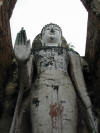|
abhaya (अभय) 
Sanskrit. ‘Fearless’. A
mudra
symbolizing ‘calm’,
‘reassurance’
and ‘no fear’, and which in India is often performed by
sadhu (fig.),
whereas in
Buddhism
it refers to a scene in which the
Buddha prevented
bloodshed in a quarrel over water and is commonly
seen associated with standing or
walking Buddha
images. The position with the right hand raised and palm forward is called
pahng hahm yaat (fig.)
and
symbolizes the Buddha's offer, to his followers, of protection or freedom from
fear.
In
iconography, the pahng
hahm yaat position is sometimes referred to as the attitude of forgiveness.
The same position with the
left hand raised
is called
pahng hahm prakaen jan.
Thailand has a
variation of this position in which the Buddha raises two hands
(fig.)
and which is known
as the mudra of ‘restraining the waters’. It refers to an episode when the
Buddha calmed the floodwaters of the Nairanjana River, a tributary of the
Ganges
in Northern India.
In Thai, this pose is called
pahng hahm samut.
Sometimes these positions are displayed next to each other (fig.).
See also
Abhaya.
回






|

